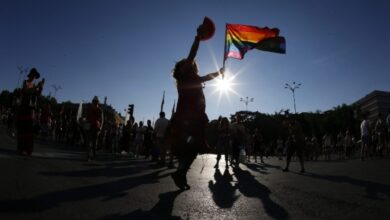TV and Movie Characters Representing the LGBTIQ+ Community
We bring you a list of characters in film and television who are proud, kind, and respectful representations of the LGBTIQ+ community.

Photos: Netflix, HBO Max
LatinAmerican Post | July Vanesa López
Escucha este artículo
Leer en español: Personajes del cine y la televisión que representan la comunidad LGBTIQ+
The struggle for rights and visibility for the LGBTIQ+ community began 54 years ago with the Stonewall riots. Since then, the progress made worldwide has shown that rights are worth fighting for, but there is still a long way to go. Today there are 67 countries where homosexuality is criminalized, and sentences can range from a few months in jail to the death penalty. Therefore, in June, we not only celebrate the diversity of gender and sexuality but also draw attention to the importance of protecting the life and integrity of the community in these countries and denounce the hatred that the community still receives.
Also read: 5 LGBTQ+ Productions that will be Released Soon and that you Cannot Miss
In this sense, visualization and representation are essential, as they allow these humanities to be normalized and help avoid prejudices based on stereotypes or victimization. Let’s look at some of the characters in film and television that provide a responsible and dignified representation of the LGBTIQ+ community.
Lesbian Representation
Elena álvarez is one of the main characters in “One Day at a Time,” a sitcom about a Latina family in the United States. She is a powerful girl who breaks away from the stereotypes surrounding lesbian women and confronts her family’s prejudices through an argumentative intelligence that is highly entertaining. However, she also shows us her more vulnerable and emotional side, which makes her a well-rounded and excellent character.
Gay Representation
Ryan Hayes, the protagonist of “Special,” is a gay man with mild cerebral palsy who has never been in a relationship for fear of how he might be treated because of his condition. He is a very human character who does not victimize himself for his sexual orientation or cerebral palsy but explores his possibilities. The series follows his journey to find the best way to live his life beyond labels. This character is not about being gay but about being a human searching for love.
Bisexual Representation
Nick Nelson is one of the main characters in “Heartstopper,” one of the most beloved series in the gay community today. Nick is a boy who discovers his bisexuality when he falls in love with his classmate, Charlie Spring. This character manages to bring to television a representation of bisexuality in which there is no stereotypical confusion but rather an interest in understanding physical and emotional attractions and accepting oneself completely without doing violence to oneself.
Transgender Representation
Elektra Evangelista is the most iconic character in “Pose.” She is one of the series’ protagonists, a trans woman who has slowly made a place in the world for herself and her friends, whom she considers daughters. Elektra unerringly represents the part of the LGBTIQ+ community that receives the most hate and violence, demonstrating how much strength, beauty, and resilience there is in her.
Intersex Representation
Alex is the protagonist of “XXY,” an Argentinean film that seeks to make inter-sexuality, rarely discussed even within the community, visible. Alex’s character conveys the emotions, feelings, and pain that exist when gender is blurred in the same body. He also explores the possibilities this offers him and shows us his strength in the face of a society that judges excessively.
Queer Representation
The gems are several characters from the series “Steven Universe” who have no defined biological sex but use the feminine pronoun. They manage to perfectly represent the queer community, which paradoxically, by definition, cannot be described. In the gems, we find beings who love unconditionally, regardless of their physical appearance, and explore the forms they can take when they come together with other gems.
Nonbinary Representation
Cal Bowman’s “Sex Education” positioned itself as one of the first and most accurate intersectional representations of non-binary black people. Moreover, this representation does not victimize but instead denounces invisibilisation on a social and institutional level. Cal puts her identity above all else and does not allow herself to be disrespected for it, even if it means challenging authority.




